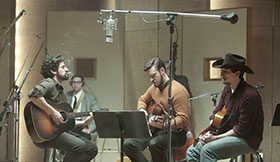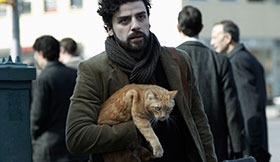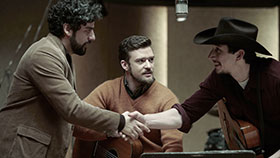
Fans of Joel and Ethan Coen’s eclectic brand of filmmaking should be thrilled with their latest effort, Inside Llewyn Davis. The story follows Llewyn Davis as a struggling folk singer in the Greenwich Village folk scene at about 1960 – just before Bob Dylan’s early career there. Davis is played by Oscar Isaac, who most recently appeared in The Bourne Legacy. The story was inspired by the life of musician Dave Van Ronk, as chronicled in the book “The Mayor of MacDougal Street”. Although this is the Coen bothers’ most recent release, the film was actually produced in 2012 in true indie filmmaking fashion – without any firm commitment for distribution. It was picked up by CBS Films earlier this year.
 The Coen brothers tackle post with a workflow that is specific to them. I had a chance to dig into that world with Katie McQuerrey, who is credited as an additional editor on Inside Llewyn Davis. McQuerrey started with the Coen brothers as they transitioned into digital post, helping to adapt their editorial style to Apple Final Cut Pro. For many of their films, she’s worn a number of hats – helping to coordinate the assistant editors, acting as a conduit to other departments and, in general, serving as another set of eyes, ears and brain while Ethan and Joel are cutting their films.
The Coen brothers tackle post with a workflow that is specific to them. I had a chance to dig into that world with Katie McQuerrey, who is credited as an additional editor on Inside Llewyn Davis. McQuerrey started with the Coen brothers as they transitioned into digital post, helping to adapt their editorial style to Apple Final Cut Pro. For many of their films, she’s worn a number of hats – helping to coordinate the assistant editors, acting as a conduit to other departments and, in general, serving as another set of eyes, ears and brain while Ethan and Joel are cutting their films.
 McQuerrey explained, “Ethan and Joel adapted their approach from how they used to cut on film. Ethan would pull selects from film workprint on a Moviola and then Joel would assemble scenes from these selects using a KEM. With Final Cut Pro, they each have a workstation and these are networked together. No fancy SAN management. Just Apple file sharing and a Promise storage array for media. Ethan will go through a project, review all the takes, make marks, add markers or written notes and pass it over to Joel. Ethan doesn’t actually assemble anything to a timeline. He’s only working within the bins of the broader project. All of the timeline editing of these scenes is then done by Joel.” (Although there’s been press about the Coen brothers planning to use Adobe Premiere Pro in the future, this film was still edited using Apple Final Cut Pro 7.)
McQuerrey explained, “Ethan and Joel adapted their approach from how they used to cut on film. Ethan would pull selects from film workprint on a Moviola and then Joel would assemble scenes from these selects using a KEM. With Final Cut Pro, they each have a workstation and these are networked together. No fancy SAN management. Just Apple file sharing and a Promise storage array for media. Ethan will go through a project, review all the takes, make marks, add markers or written notes and pass it over to Joel. Ethan doesn’t actually assemble anything to a timeline. He’s only working within the bins of the broader project. All of the timeline editing of these scenes is then done by Joel.” (Although there’s been press about the Coen brothers planning to use Adobe Premiere Pro in the future, this film was still edited using Apple Final Cut Pro 7.)
 Inside Llewyn Davis was filmed on 35mm over the course of a 45-day production in 2012. It wrapped on April 4th and was followed by a 20 to 24-week post schedule, ending in a final mix by the end of September. Technicolor in New York provided lab and transfer services for the production. They scanned in all of the raw 35mm negative one time to DPX files with a 2K resolution and performed a “best light” color correction pass of the DPX files for dailies. In addition, Technicolor also synced the sound from the mono mix of production mixer Peter Kurland’s location recordings. These were delivered to the editorial team as synced ProRes files.
Inside Llewyn Davis was filmed on 35mm over the course of a 45-day production in 2012. It wrapped on April 4th and was followed by a 20 to 24-week post schedule, ending in a final mix by the end of September. Technicolor in New York provided lab and transfer services for the production. They scanned in all of the raw 35mm negative one time to DPX files with a 2K resolution and performed a “best light” color correction pass of the DPX files for dailies. In addition, Technicolor also synced the sound from the mono mix of production mixer Peter Kurland’s location recordings. These were delivered to the editorial team as synced ProRes files.
 McQuerrey said, “Ethan and Joel don’t cut during the shooting. That doesn’t start until the production wraps. Inside Llewyn Davis has a look for many of the scenes reminiscent of the era. [Director of photography] Bruno Delbonnel worked closely with [colorist] Peter Doyle to establish a suggested look during the dailies. These would be reviewed on location in a production trailer equipped with a 50” Panasonic plasma that Technicolor had calibrated. Once the film was locked, then Technicolor conformed the DPX files and Bruno, Ethan and Joel supervised the DI mastering of the film. Peter graded both the dailies and the final version using a [Filmlight] Baselight system. Naturally, the suggested look was honed and perfected in the final DI.”
McQuerrey said, “Ethan and Joel don’t cut during the shooting. That doesn’t start until the production wraps. Inside Llewyn Davis has a look for many of the scenes reminiscent of the era. [Director of photography] Bruno Delbonnel worked closely with [colorist] Peter Doyle to establish a suggested look during the dailies. These would be reviewed on location in a production trailer equipped with a 50” Panasonic plasma that Technicolor had calibrated. Once the film was locked, then Technicolor conformed the DPX files and Bruno, Ethan and Joel supervised the DI mastering of the film. Peter graded both the dailies and the final version using a [Filmlight] Baselight system. Naturally, the suggested look was honed and perfected in the final DI.”
 “Inside Llewyn Davis is about a musician and music is a major component of the film. The intent was to be as authentic as possible. There was no lip-syncing to the playback of a recorded music track. Peter [Kurland] recorded all of these live on set and that’s what ended up in the final mix. For editing, if we ever needed to separate tracks, then we’d go back to Peter’s broadcast wave file multi-track recordings, bring those into Final Cut and create ‘merged clips’ that were synced. Since Ethan and Joel’s offices are in a small building, the assistants had a separate cutting room at Post Factory in New York. We mirrored the media at both locations and I handled the communication between the two offices. Often this was done using Mac screen sharing between the computers.”
“Inside Llewyn Davis is about a musician and music is a major component of the film. The intent was to be as authentic as possible. There was no lip-syncing to the playback of a recorded music track. Peter [Kurland] recorded all of these live on set and that’s what ended up in the final mix. For editing, if we ever needed to separate tracks, then we’d go back to Peter’s broadcast wave file multi-track recordings, bring those into Final Cut and create ‘merged clips’ that were synced. Since Ethan and Joel’s offices are in a small building, the assistants had a separate cutting room at Post Factory in New York. We mirrored the media at both locations and I handled the communication between the two offices. Often this was done using Mac screen sharing between the computers.”
 The Coen brothers approach their films in a very methodical fashion, so editing doesn’t present the kinds of challenges that might be the case with other directors. McQuerrey explained, “Ethan and Joel have a very good sense of script time to film time. They also understand how the script will translate on screen. They’ll storyboard the entire film, so there’s no improvisation for the editor to deal with. Most scenes are filmed with a traditional, single-camera set-up. This film was within minutes of the right length at the first assembly, so most of the editorial changes were minor trims and honing the cut. No significant scene lifts were made. Joel’s process is usually to do a rough cut and then a first cut. Skip Lievsay, our supervising sound editor, will do a temp mix in [Avid] Pro Tools. This cut with the temp mix will be internally screened for ‘friends and family’, plus the sound team and visual effects department. We then go back through the film top to bottom, creating a second cut with another temp mix.”
The Coen brothers approach their films in a very methodical fashion, so editing doesn’t present the kinds of challenges that might be the case with other directors. McQuerrey explained, “Ethan and Joel have a very good sense of script time to film time. They also understand how the script will translate on screen. They’ll storyboard the entire film, so there’s no improvisation for the editor to deal with. Most scenes are filmed with a traditional, single-camera set-up. This film was within minutes of the right length at the first assembly, so most of the editorial changes were minor trims and honing the cut. No significant scene lifts were made. Joel’s process is usually to do a rough cut and then a first cut. Skip Lievsay, our supervising sound editor, will do a temp mix in [Avid] Pro Tools. This cut with the temp mix will be internally screened for ‘friends and family’, plus the sound team and visual effects department. We then go back through the film top to bottom, creating a second cut with another temp mix.”
“At this stage, some of the visual effects shots have been completed and dropped into the cut. Then there’s more honing, more effects in place and finally another temp mix in 5.1 surround. This will be output to D5 for more formal screenings. Skip builds temp mixes that get pretty involved, so each time we send OMF files and change lists. Sound effects and ADR are addressed at each temp mix. The final mix was done in five days at Sony in Los Angeles with Skip and Greg Orloff working as the re-recording mixers.”
 Even the most organized production includes some elements that are tough to cut. For Inside Llewyn Davis, this was the cross-country driving sequence that covers about one-and-a-half reels of the film. It includes another Coen favorite, John Goodman. McQuerrey described, “The driving scenes were all shot as green-screen composites. There are constantly three actors in the car, plus a cat. It’s always a challenge to cut this type of scene, because you are dealing with the continuity from take to take of all three actors in a confined space. The cat, of course, is less under anyone’s control. We ‘cheated’ that a bit using seamless split-screens to composite the shots in a way that the cat was in the right place. All of the windows had to be composited with the appropriate background scenery.”
Even the most organized production includes some elements that are tough to cut. For Inside Llewyn Davis, this was the cross-country driving sequence that covers about one-and-a-half reels of the film. It includes another Coen favorite, John Goodman. McQuerrey described, “The driving scenes were all shot as green-screen composites. There are constantly three actors in the car, plus a cat. It’s always a challenge to cut this type of scene, because you are dealing with the continuity from take to take of all three actors in a confined space. The cat, of course, is less under anyone’s control. We ‘cheated’ that a bit using seamless split-screens to composite the shots in a way that the cat was in the right place. All of the windows had to be composited with the appropriate background scenery.”
“The most interesting part of the cut was how the first and last scenes were built. The beginning of the movie and the ending are the same event, but the audience may not realize at first that they are back at the beginning of the story. This was filmed only one time, but each scene was edited in a slightly different way, so initially you aren’t quite sure if you’ve seen this before or not. Actions in the first scene are abbreviated, but are then resolved with more exposition at the end.”
Originally written for Digital Video magazine
©2013 Oliver Peters